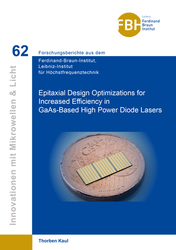| Departments | |
|---|---|
| Book Series (96) |
1378
|
| Nachhaltigkeit |
3
|
| Gesundheitswesen |
1
|
| Humanities |
2364
|
| Natural Sciences |
5406
|
| Mathematics | 229 |
| Informatics | 319 |
| Physics | 980 |
| Chemistry | 1363 |
| Geosciences | 131 |
| Human medicine | 243 |
| Stomatology | 10 |
| Veterinary medicine | 108 |
| Pharmacy | 147 |
| Biology | 835 |
| Biochemistry, molecular biology, gene technology | 121 |
| Biophysics | 25 |
| Domestic and nutritional science | 45 |
| Agricultural science | 1004 |
| Forest science | 201 |
| Horticultural science | 20 |
| Environmental research, ecology and landscape conservation | 148 |
| Engineering |
1793
|
| Common |
98
|
|
Leitlinien Unfallchirurgie
5. Auflage bestellen |
|
Advanced Search
Epitaxial Design Optimizations for Increased Efficiency in GaAs-Based High Power Diode Lasers (Volume 62) (English shop)
Thorben Kaul (Author)Preview
Extract, PDF (2.1 MB)
Table of Contents, PDF (40 KB)
This work presents progress in the root-cause analysis of power saturation mechanisms in continuous wave (CW) driven GaAs-based high-power broad area diode lasers operated at 935 nm. Target is to increase efficiency at high optical CW powers by epitaxial design.
The novel extreme triple asymmetric (ETAS) design was developed and patented within this work to equip diode lasers that use an extremely thin p-waveguide with a high modal gain. An iterative variation of diode lasers employing ETAS designs was used to experimentally clarify the impact of modal gain on the temperature dependence of internal differential quantum efficiency (IDQE) and optical loss. High modal gain leads to increased free carrier absorption from the active region. However, less power saturation is observed, which must then be attributed to an improved temperature sensitivity of the IDQE.
The effect of longitudinal spatial hole burning (LSHB) leads to above average non-linear carrier loss at the back facet of the device. At high CW currents the junction temperature rises. Therefore, not only the asymmetry of the carrier profile increases but also the average carrier density in order to compensate for the decreased material gain and increased threshold gain. This carrier non-pinning effect above threshold is found in this work to enhance the impact of LSHB already at low currents, leading to rapid degradation of IDQE with temperature.
This finding puts LSHB into a new context for CW-driven devices as it emphasizes the importance of low carrier densities at threshold. The carrier density was effectively reduced by applying the novel ETAS design. This enabled diode lasers to be realized that show minimized degradation of IDQE with temperature and therefore improved performance in CW operation.
| ISBN-13 (Hard Copy) | 9783736973961 |
| ISBN-13 (eBook) | 9783736963962 |
| Final Book Format | A5 |
| Language | English |
| Page Number | 136 |
| Lamination of Cover | matt |
| Edition | 1 |
| Book Series | Innovationen mit Mikrowellen und Licht. Forschungsberichte aus dem Ferdinand-Braun-Institut, Leibniz-Institut für Höchstfrequenztechnik |
| Volume | 62 |
| Publication Place | Göttingen |
| Place of Dissertation | Berlin |
| Publication Date | 2021-04-09 |
| General Categorization | Dissertation |
| Departments |
Physics
Physics of condensed matter (including physics of solid bodies, optics) |
| Keywords | GaAs, AlGaAs, InGaAs, Diodenlaser, Laser, Diodenlaserbarren, Diodenlaser-Stack, Hochleistungsdiodenlaser, Hochleistung, Hocheffizient, Einfach Quantentopf, Mehrfach Quantentopf, Ladungsträgerdichte, Schwellenladungsträgerdichte, Longitudinales räumliches Lochbrennen, Ladungsträger Non-Pinning, Zwei-Photon Absorption, Freie Ladungsträger Verluste, Absorptionsquerschnitte, Optische Verluste, Interne differentielle Quanteneffizienz, Modeneinschluss Faktor, Optischer Modeneinschluss, Leckströme, Ladungsträgerverluste, Ladungsträgeraustritt, Thermische Ladungsträgerverluste, Ladungsträger Akkumulation, Stromgetriebene Ladungsträgerverluste, Laserstrahl, Leistungssättigung, Leistungslimitierende Mechanismen, Thermisches Überrollen, Leistungskonversionseffizienz, Dauerstrich, Optischer Gewinn, Differentieller Gewinn, Modaler Gewinn, Materialgewinn, Bandkantenbiegung, Epitaktische Struktur, Epitaktisches Design, Vertikalstruktur, D-Factor, EDAS, Extrem doppelasymmetrische Struktur, Extrem dreifach asymmetrische Struktur, MOVPE, Metallorganische Gasphasenepitaxie, Optischer Wellenleiter, Mantelschicht, TRUMPF, Laserindustrie, Festkörperlaser, Scheibenlaser, Optisches Pumpen, Optische Pumpen, Materialbearbeitung, GaAs, AlGaAs, InGaAs, Diode Laser, Lasers, Diode Laser Bar, Diode Laser Stack, High Power, High Efficiency, Single Quantum Well, Multi Quantum Well, Carrier Density, Threshold Carrier Density, Longitudinal Spatial Hole Burning, Carrier Non-Pinning, Two-Photon Absorption, Free Carrier Absorption Loss, Absorption Cross Sections, Optical Loss, Internal Differential Quantum Efficiency, Confinement Factor, Optical Confinement, Leakage Currents, Carrier Loss, Carrier Escape, Thermal carrier Leakage, Carrier Accumulation, Bias Driven Carrier Leakage, Laser Beam, Power Saturation, Power limiting Mechanisms, Thermal Rollover, Power Conversion Efficiency, Continuous Wave, Optical Gain, Differential Gain, Modal Gain, Material Gain, Band Edge Bending, Epitaxial Structure, Epitaxial Design, Vertical Structure, D-Factor, EDAS, Extreme Double Asymmetric Structure, ETAS, Extreme Triple Asymmetric Structure, MOVPE, Metalorganic Vapor Phase Epitaxy, Optical Waveguide, Cladding Layer, TRUMPF, Laser Industry, Solid State Lasers, Disc Lasers, Optical Pumping, Optical Pumps, Material Processing |
| URL to External Homepage | https://www.fbh-berlin.de/publikationen-patente/dissertationen |








